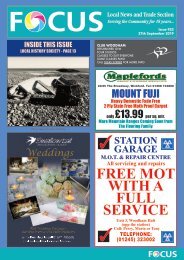IngAUG
Create successful ePaper yourself
Turn your PDF publications into a flip-book with our unique Google optimized e-Paper software.
The Arts Society, Brentwood District<br />
(formerly Brentwood & District Decorative and Fine Arts Society)<br />
The English have long had a taste for portraits. When the National<br />
Portrait Gallery opened in London in 1856, it was the first such<br />
gallery in the world.<br />
In our June talk Looking at Portraits - A very English Taste, Val<br />
Woodgate explored why and how this English passion has<br />
influenced painting in this country. An early Italian commentator<br />
remarked that portraits were regarded as more special in England<br />
than any country due to “our self-love”. Val’s explanation was more<br />
prosaic. Before the Reformation in the 16th century, artists – and<br />
their patrons – concentrated on religious paintings. After the<br />
Reformation, these paintings were no longer acceptable. For the<br />
next 200 years, portraiture took their place. Indeed, religious art did<br />
not simply go out of fashion. From the establishment of the Church<br />
of England by Henry VIII in 1534 to the Restoration of Charles II in<br />
1660, 95% of English religious art was destroyed.<br />
Until relatively recently, artists needed patrons to make a living.<br />
William Hogarth in the 18th century was the first to be self-financing<br />
and thrive without a patron. So, after 1534, artists had to find a new<br />
topic for paintings that would attract patrons. And they found<br />
portraiture. At first, portraits, like those of earlier kings, were drawn<br />
from earlier records, descriptions, sketches or just imagination. The<br />
father of painting from real life in England was Hans Holbein, a<br />
German painter who came to live in England. His portrait of Henry<br />
VIII from real life set the standard. As did his The Ambassadors<br />
painted in 1533. It had amazing realism, vivid colours and no visible<br />
brush strokes. The closer you get, the more you see.<br />
Portraits can have many purposes. Bequeathing a likeness to<br />
posterity is only one of them. For Royals, politics has often been the<br />
primary purpose. Particularly at a time<br />
when paintings were a key medium<br />
for messages. Take the time of<br />
Elizabeth I. When she came<br />
to the throne, she decreed<br />
that no more portraits were<br />
to be painted of her until a<br />
portrait design had been<br />
approved. Portraits were<br />
an important political tool.<br />
It was six years before<br />
Nicholas Hilliard, the Court<br />
miniaturist, painted the first<br />
portrait of her as Queen. One<br />
of the design rules was that no<br />
shadows should be shown, so her<br />
portraits are difficult to date. Each<br />
portrait carried political statements, whether to<br />
do with the defeat of the Armada or her role as the Virgin Queen.<br />
Only a few were painted from real life. But many were copied from<br />
approved paintings onto a large number of objects and widely<br />
circulated to meet a strong demand.<br />
Anthony Van Dyke, a Flemish painter who became Court Painter to<br />
Charles I, became another powerful influence on English portraiture.<br />
His very different brush strokes from Holbein gives a sense of<br />
movement. His portrait of a mounted Charles I became a template<br />
for many later paintings.<br />
But iconic portraits were not just for Royals. By the 18th century,<br />
when English masters of the portrait really came into their own, it<br />
was the gentry and the successful business leaders who became<br />
patrons. Thomas Gainsborough and Joshua Reynolds put English<br />
8<br />
portraiture on the map. Gainsborough’s Mr and Mrs Andrew’s<br />
became a painting classic. As did Reynolds’ Captain Robert Orme.<br />
Portraiture has continued to play a leading role in English painting up<br />
to the present day. Portraits of the Queen by Pietro Annigoni and<br />
Lucien Freud hit the headlines. David Hockney’s Mr and Mrs Clark<br />
and Percy became one of his best-known paintings. Someone<br />
selling a flat shown in the background of this portrait made that a big<br />
selling point. The National Portrait Gallery is always packed. The<br />
country is still in love with portraits.<br />
Our next talk is on Wednesday 19<br />
September 2018, when Hilary<br />
Williams’ subject will be William<br />
Hogarth – a Harlot, a Rake and a<br />
Marriage. Hilary was formerly Print<br />
Room Superintendent at the British<br />
Museum and is now the Art History<br />
Education Officer. She lectures for<br />
the British Museum, London<br />
Borough of Bexley and the Wallace<br />
Collection. She is also Liaison<br />
officer at the British Museum with<br />
The Arts Society. As well as being<br />
Founding Artistic Director of The<br />
Arts Society of North Kent Evening<br />
she guides Special Interest Private<br />
Tours of State Apartments at<br />
Buckingham Palace.<br />
Left:<br />
Gainsborough’s<br />
Mr and Mrs<br />
Andrews.<br />
Below:<br />
Annigoni’s1955<br />
Portrait of the<br />
Queen.<br />
Hilary's lecture will be about Hogarth, born in London, the son of an<br />
unsuccessful schoolmaster and writer from Westmoreland. After<br />
apprenticeship to a goldsmith, he began to produce his own<br />
engraved designs in about 1710. He later took up oil painting,<br />
starting with small portrait groups called conversation pieces. He<br />
went on to create a series of paintings satirising contemporary<br />
customs, but based on earlier Italian prints, of which the first was<br />
The Harlot's Progress (1731), and perhaps the most famous The<br />
Rake's Progress. In 1743 he painted the series famously entitled<br />
Marriage A-la-Mode His engravings were so plagiarised that he<br />
lobbied for the Copyright Act of 1735 as protection for writers and<br />
artists.<br />
Our talks are at the Community Hall, Ingatestone at 7.30 for 8pm,<br />
usually on the 3rd Wednesday of each month. Visitors are always<br />
welcome. The entrance fee for visitors is £7. There is plenty of<br />
parking. Full details of our future talks and other activities are on our<br />
website http:// tasbd.org.uk . If you’d like more information or to<br />
ask about our activities, call our Membership Secretary Diana<br />
Bandy on 01277 353178 or our Deputy Chairman Strachan<br />
Heppell on 01277 353418.<br />
The Journal


















